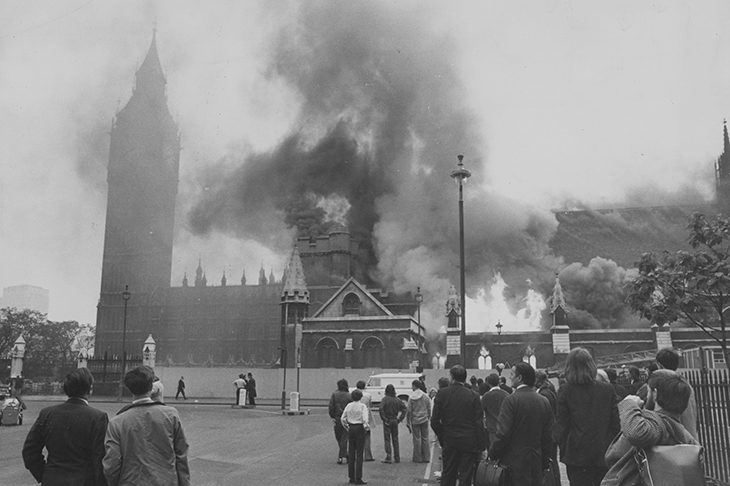It was said that Reginald Maudling, as home secretary, once boarded a plane in Belfast and immediately requested a stiff drink, muttering: ‘Get me out of this awful bloody country!’ This does not appear in Ian Cobain’s compelling, interwoven narrative about a killing in Lisburn, near Belfast, in April 1978, but it emblemised some of London’s attitudes to what was sometimes called ‘Ulster’.
Even during the height of the Troubles, with daily shootings, bombings and killings, the Province was frequently ignored at cabinet level: the spirit of Maudling prevailed in both Conservative and Labour administrations. By Cobain’s measure, Labour’s Roy Mason was as bad as any Tory. His hardline swaggering approach provoked the IRA into ever more intense terrorist activity.
Cobain’s main focus is on a particular killing on a particular day: the carefully planned homicide of the off-duty policeman Millar McAllister at home. The act itself, carried out by Harry Murray, a Protestant who had joined the IRA (and previously served in the RAF), is described in almost filmic detail, as Harry, supported by getaway car and a young woman accomplice, makes his way towards the location. Touchingly, the victim was a pigeon-fancier — most harmless of hobbies — and it was through his despatches for Pigeon Racing News and Gazette that he was located.
Cobain is surely right that it is humiliation, not deprivation, that often prompts terrorism
The shooter engages in conversation with the target at his bungalow door. It’s awkward that the policeman’s young son is by his side. But the ‘op’ must be done. Harry takes aim, shoots McAllister in forehead, sternum and left and right of chest: he called this ‘the sign of the cross’, as it were ‘blessing’ the dying body.
It is a terrible scene, but like much in this remarkable account, dramatic and suspenseful: it communicates the excitement with which a killer approaches a CQA (close-quarter assassination). The story of one Glen Espie, a plumber and part-time soldier, and how he escaped just such a CQA has the elements of a thriller.
Behind these individual lives, Cobain has woven a detailed contextual background of the history and sociology of Northern Ireland and the many political blunders associated with its mismanagement. He is unblinkingly honest about all the actors in this theatre of war. The IRA’s actions were heartless, but they were not stupid: they were often strategic. Cobain describes in detail how suspects were repeatedly beaten up at Castlereagh interrogation centre, which was both ineffective and unlawful.
This is very fine journalism — reportage with thoroughly researched context. Some of Cobain’s judgments would not be shared by everyone. The Peace People deserve more praise — they sowed the seeds of peace. And the IRA hunger-striker Bobby Sands is not a hero to all. Dublin’s Garret Fitzgerald was horrified to be brought to a ‘Bobby Sands Street’ on a visit to Uzbekistan. But Cobain is surely right in concluding that it is humiliation, not deprivation, that often prompts terrorist activism.
The Irish journalist Kevin Myers has trodden some of the same ground in 1970s Belfast, notably in the previous darkly funny Watching the Door. Burning Heresies is more of a panoramic collection of his journalistic and personal life since he was hired by the Irish Times in 1979. Douglas Gageby, its editor, is considered one of Ireland’s most successful: he turned a Protestant, Unionist newspaper into a perfect fit for a rising Catholic bourgeoisie. As an Irish Protestant, he was a quixotic nationalist. There’s a droll moment when Gageby spikes a piece of Kevin’s so emphatically that ‘he narrowly avoided gaining Ireland’s first Protestant stigmata’. Myers is shamelessly truthful about the real conditions of journalism, as they were — the role of the pub, the ‘Gutenbergian’ unions. And bias didn’t begin with the internet.
His highly readable reportage covers Ireland, Lebanon, the Balkans, Africa and Panama, sometimes including near-death experiences. But he is most engaging on Ireland, and the many personalities he describes are vividly evoked. He’s brilliantly savage on a hypocritical priest, Michael Cleary, all the more odious for his attempts to be trendily lewd.
The specific heresy of the title involves Myers’s sacking from the Irish edition of the Sunday Times in 2017 for a column misread as anti-Semitic: a passage was maladroitly phrased, and a good sub-editor should have corrected that. Myers, always pro-Jewish, was sacked, libelled and pilloried globally via Twitter, his reputation ruined. The episode illuminates how social media can change a life instantly and how quickly ‘cancel culture’ has taken hold.
The most important part of Myers’s story focuses on how he rescued the archival memory of the 40,000 Irishmen who died in the 1914-18 war. They had been consigned to national amnesia. He saved not only their memory, but also their decayed Dublin memorial park that had become a dump. The Queen personally thanked him on her 2011 visit, and so will history and generations to come.






Comments